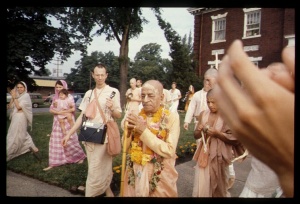We have heard the names of so many different yogas and yogīs, but in Bhagavad-gītā Kṛṣṇa says that the actual yogī is he who has surrendered himself "fully unto Me." Kṛṣṇa proclaims that there is no difference between renunciation (sannyāsa) and yoga (BG 6.2):
- yaṁ sannyāsam iti prāhur
- yogaṁ taṁ viddhi pāṇḍava
- na hy asannyasta-saṅkalpo
- yogī bhavati kaścana
"What is called renunciation is the same as yoga, or linking oneself with the Supreme; for no one can become a yogī unless he renounces the desire for sense gratification."
In Bhagavad-gītā there are three basic types of yoga delineated - karma-yoga, jñāna-yoga and bhakti-yoga. The systems of yoga may be likened to a staircase. Someone may be on the first step, someone may be halfway up, or someone may be on the top step. When one is elevated to certain levels, he is known as a karma-yogī, jñāna-yogī, etc. In all cases, the service to the Supreme Lord is the same. It is a difference in elevation only. Thus Śrī Kṛṣṇa tells Arjuna that he must understand that renunciation (sannyāsa) and yoga are the same, because without being freed from desire and sense gratification one can become neither a yogī nor a sannyāsī.
There are some yogīs who perform yoga for a profit, but that is not real yoga. Everything must be engaged in the service of the Lord. Whatever we do as an ordinary worker or as a sannyāsī or as a yogī or as a philosopher must be done in Kṛṣṇa consciousness. When we are absorbed in the thought of serving Kṛṣṇa and when we act in that consciousness, we can become real sannyāsīs and real yogīs. for those who are taking the first step up the staircase of the yoga system, there is work. One should not think that simply because he is beginning yoga he should stop working. In Bhagavad-gītā Kṛṣṇa asks Arjuna to become a yogī, but He never tells him to cease from fighting. Quite the contrary. Of course, one may ask how a person may be a yogī and at the same time a warrior. Our conception of yoga practice is that of sitting very straight, with legs crossed and eyes half-closed, staring at the tip of our nose and concentrating in this way in a lonely place. So how is it that Kṛṣṇa is asking Arjuna to become a yogī and at the same time participate in a ghastly civil war? That is the mystery of Bhagavad-gītā: one can remain a fighting man and at the same time be the highest yogī, the highest sannyāsī. How is this possible? In Kṛṣṇa consciousness. One simply has to fight for Kṛṣṇa, work for Kṛṣṇa, eat for Kṛṣṇa, sleep for Kṛṣṇa and dedicate all activities to Kṛṣṇa. In this way one becomes the highest yogī and the highest sannyāsī. That is the secret.
In the Sixth Chapter of Bhagavad-gītā, Śrī Kṛṣṇa instructs Arjuna how to perform meditational yoga, but Arjuna rejects this as too difficult. How then is Arjuna considered to be a great yogī? Although Kṛṣṇa saw that Arjuna was rejecting the meditational system, He proclaimed Arjuna to be the highest yogī because "You are always thinking of Me." Thinking of Kṛṣṇa is the essence of all yoga systems - of the haṭha, karma, jñāna, bhakti or any other system of yoga, sacrifice or charity. All the recommended activities for spiritual realization end in Kṛṣṇa consciousness, in thinking always of Kṛṣṇa. The actual perfection of human life lies in being always Kṛṣṇa conscious and always being aware of Kṛṣṇa while performing all types of activities.
In the preliminary stage one is advised to always work for Kṛṣṇa. One must be always searching out some duty or some engagement, for it is a bad policy to remain idle even for a second. When one actually becomes advanced through such engagements, then he may not work physically, but he is always engaged within by constantly thinking of Kṛṣṇa. In the preliminary stage, however, one is always advised to engage one's senses in the service of Kṛṣṇa. There are a variety of activities one can perform in serving Kṛṣṇa. The International Society for Krishna Consciousness is intended to help direct aspirant devotees in these activities. for those working in Kṛṣṇa consciousness, there are simply not enough hours in the day to serve Kṛṣṇa. There are always activities, engagements both day and night, which the student of Kṛṣṇa consciousness performs joyfully. That is the stage of real happiness - constant engagement for Kṛṣṇa and spreading Kṛṣṇa consciousness around the world. In the material world one may become very tired if he works all the time, but if one works in Kṛṣṇa consciousness, he can chant Hare Kṛṣṇa and engage in devotional service twenty-four hours a day and never get tired. But if we vibrate some mundane vibration, then we soon become exhausted. There is no question of becoming tired on the spiritual platform. The spiritual platform is absolute. In the material world everyone is working for sense gratification. The profits of one's labor in the material world are used to gratify one's senses. But a real yogī does not desire such fruits. He has no desire other than Kṛṣṇa, and Kṛṣṇa is already there.
